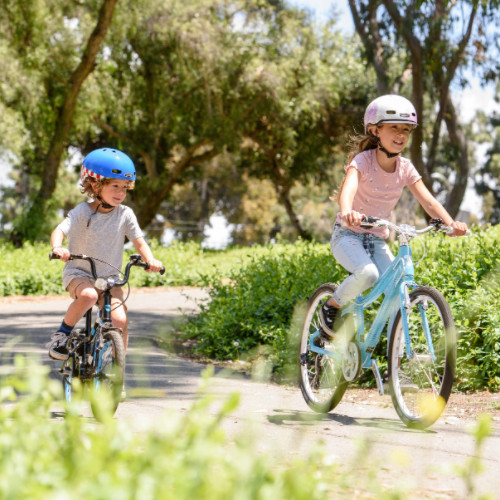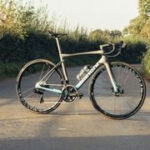Why Getting the Right Kids Bike Size Matters
Choosing the right bike size for your child is crucial for their safety and enjoyment. A bike that’s too big or too small can make learning to ride difficult, leading to frustration and potentially accidents. Proper bike fit ensures comfort, control, and confidence, making biking a positive experience from the start.
The Pitfalls of Traditional Kids Bike Size Charts (Age & Wheel Size)
Many traditional kids bike size charts rely on age or wheel size as the primary sizing factors. However, this approach can be misleading. Here’s why:
- Individual Differences: Children of the same age can vary significantly in height and leg length. An age-based chart assumes an average child, which may not apply to your child’s unique proportions.
- Brand Variations: Bike sizing isn’t standardized across brands. A 16-inch bike from one manufacturer might have a different frame geometry and seat height compared to another, even if they share the same wheel size. Brands like Guardian Bikes specifically design bikes with kids’ unique needs in mind, further highlighting the variability.
These factors mean relying solely on age or wheel size charts can lead to inaccurate recommendations and a poorly fitted bike.
Introducing the Leg Length Method: A Better Way to Size Kids Bikes
The most effective way to determine the right kids bike size is by focusing on your child’s leg length (inseam) and their riding experience. This method provides a more personalized and accurate fit compared to age or wheel size charts.
Measuring Your Child’s Bike Leg Length: Step-by-Step
To accurately measure your child’s bike leg length, follow these simple steps:
- Stand tall: Have your child stand straight against a wall with their feet shoulder-width apart, wearing their usual shoes.
- Use a book (optional but recommended): For greater precision, place a hardbound book between their legs, gently pressing upwards to simulate a bike seat.
- Measure to the crotch: Measure the distance from the ground up to the top of the book (or to their crotch if not using a book). This measurement is their bike leg length.
Alt text: Step-by-step illustration of measuring a child’s bike leg length, showing a child standing against a wall with a book placed between their legs and measuring from the ground to the top of the book.
Important Note: Bike leg length is different from pant leg length. We are measuring the inseam specifically for bike fitting.
Rider Experience Levels and Bike Fit
Once you have your child’s bike leg length, consider their riding experience to determine the ideal seat height and bike size. Rider experience plays a crucial role in how comfortably and confidently they can handle a bike.
First Pedal Bike – No Balance Bike Experience
If your child is transitioning directly to a pedal bike without prior balance bike experience, it’s essential that they can comfortably place both feet flat on the ground while seated. This allows them to feel stable and in control as they learn to balance and pedal simultaneously.
Alt text: Image depicting a child sitting on a bike with feet flat on the ground, illustrating the appropriate fit for a beginner rider with no balance bike experience.
First Pedal Bike – Balance Bike Experience (Timid Riders)
For children who have used a balance bike but are still hesitant or timid riders on a pedal bike, having their feet flat on the ground while seated provides a sense of security and helps them build confidence.
Alt text: A child on their first pedal bike with feet flat on the ground, suitable for timid riders transitioning from a balance bike.
First Pedal Bike – Balance Bike Experience (Confident Riders)
Confident riders who have experience with balance bikes can start with a slightly higher seat position. In this case, their heels can be up to 2 inches off the ground while seated. This allows for better leg extension during pedaling while still maintaining some foot contact for balance.
Alt text: Image of a confident child rider on their first pedal bike, showing heels slightly raised (up to 2 inches off the ground) while seated.
Second (or More) Pedal Bike – Experienced Riders
For children who are already comfortable riding a pedal bike without training wheels, a more efficient riding position is recommended. Experienced riders should have their heels 2-3 inches off the ground when seated. This allows for optimal leg extension during pedaling, maximizing power and efficiency. This also means the bike will last them longer as they grow.
Alt text: A confident child rider on their second or later pedal bike with heels 2-3 inches off the ground, demonstrating proper leg extension for experienced riders.
How to Use Leg Length and Rider Experience to Find the Right Bike Size
To find the right bike size, match your child’s bike leg length and rider experience to the bike’s minimum seat height. Ideally, you want to choose a bike where your child’s leg length is at or slightly above the minimum seat height. This ensures a comfortable starting position with room to grow as they get taller.
Minimum seat height = Bike Leg Length + Heels off the ground (based on rider experience)
Example: A new rider with an 18-inch bike leg length:
- Bike Leg Length: 18 inches
- Heels off the ground (new rider): 0 inches
- Minimum seat height: 18 inches
Therefore, you would look for bikes with a minimum seat height of around 18 inches for this child.
The RideSizer® Tool: Simplifying Kids Bike Sizing
Guardian Bikes offers a helpful tool called RideSizer® designed to simplify the bike sizing process. This patented tool takes into account your child’s height or leg length and riding experience to recommend the perfect Guardian bike size.
 Second Pedal Bike
Second Pedal Bike
Alt text: Group of diverse kids happily riding Guardian Bikes, showcasing the brand’s focus on providing appropriately sized bikes for children.
RideSizer® boasts a high accuracy rate (over 98%) thanks to continuous improvement based on customer feedback. While specifically designed for Guardian Bikes, the concept of using leg length and experience remains universally applicable when choosing any kids bike.
Balance Bikes vs. Pedal Bikes: Sizing Considerations
For children under 4 who are new to biking, balance bikes are an excellent starting point. Unlike traditional bikes with training wheels, balance bikes focus on developing balance and coordination first, making the transition to pedal bikes smoother and faster.
Balance Bike Fit
When sizing a balance bike, ensure your child can comfortably place both feet flat on the ground while seated with a slightly upright posture, similar to walking. This allows them to easily propel themselves and develop their balance effectively.
Alt text: A young child comfortably seated on a balance bike with feet flat on the ground, demonstrating the ideal fit for balance bike learning.
Conclusion: Ensuring a Safe and Enjoyable Ride with the Right Bike Size Chart for Kids
Choosing the right bike size for your child is an investment in their biking journey. By moving beyond traditional age and wheel size charts and focusing on leg length and rider experience, you can ensure a comfortable, safe, and enjoyable riding experience. This approach not only helps them learn to ride more easily but also fosters a lifelong love for cycling.

